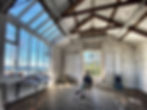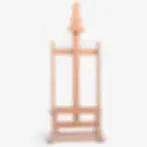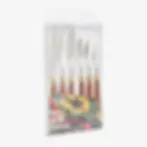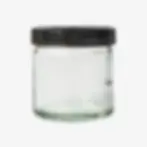Creating the Perfect Home Art Studio: Tips for a Functional and Inspiring Space
- cheshireartclasses
- Feb 27
- 4 min read
Updated: Sep 5
As much as we would all love a beautiful art studio nestled in a remote Cornish retreat or overlooking the streets of Florence, the reality for most artists is a home studio—whether it's a spare room, dining table, or a dedicated painting shed. Making the most of your space is essential for productivity and creativity. Over time, I’ve discovered some key strategies to improve a home art studio, from controlling lighting to reducing the use of harsh chemicals and maintaining an efficient workflow.

Optimising Your Lighting
Lighting plays a crucial role in how you perceive colours and details in your work. While natural light is ideal, it's not always available, especially in the evenings or on gloomy days. To maintain consistency:
Use daylight bulbs (5000K–6500K) to mimic natural light and avoid colour distortion.
Position your lighting correctly, ideally coming from above or the side, to reduce glare and shadows.
Use adjustable lamps to direct light exactly where you need it.
This daylight lighting floor lamp has completely transformed my painting process. No more surprises when I check my work the next day – morning or evening, the colours stay consistent. Matching colours is so much easier under steady lighting, making palette setup far more predictable. If you struggle with changing light conditions, I highly recommend giving this a try!
Reducing the Use of Smelly Chemicals
Traditional painting materials often involve strong-smelling solvents that can be overwhelming in a home environment. Fortunately, there are alternatives:
Switch to odourless solvents like low-odour mineral spirits. (links below)
Use a well-ventilated space by keeping windows open or using an air purifier.
As I paint in my own home, keeping toxic chemicals away is really important. That’s why I use odourless mineral spirits and the LEAN/FAT mediums—they simplify the process and make it much safer.
For the first layers of a painting, using a LEAN medium (thinner washes) is key. Then, for the top layers, switching to a FAT medium helps slow drying time and enhances the effects of linseed oil. This method keeps everything predictable and controlled!
Creating an Efficient Workflow
A well-organised space makes painting more enjoyable and productive. One of the most valuable aspects of my home setup is having a place where I can leave my palette wet and my painting to dry. This allows me to step away and analyse my work with fresh eyes, making it easy to jump back in for small changes. Here’s how to achieve a similar setup:
Use a glass palette to keep oils from drying out, improves mixing and removing dry paint off palette.
Invest in an airtight palette box for oils to extend the life of mixed colours.
Have a drying space where your paintings can rest without being disturbed.
Keep essential tools within reach—brushes, mediums, and a rag or paper towels.
The NEW WAVE: POSH palette says it all in the name! This high-grade toughened glass palette is an absolute game-changer for mixing oil paints. No scratching, easy removal of dry paint, and a huge working area—what more could you ask for?
I personally prefer the grey finish as it helps me judge light values against a midtone background. But they also offer clear and white options if that suits your style better.
The Cappelletto table easel is super sturdy, extremely well-made, and perfect for large canvases. If you’re like me and struggle with space, this easel is a fantastic solution! It sits securely on a dining table or desk, providing excellent support for both small and large canvases.
No wobble, thanks to its solid Beech wood structure, expertly crafted in Italy. Plus, I love the flexibility—it allows me to paint standing or sitting with ease. Well worth the investment!
Making Your Studio a Creative Haven
Beyond the technical setup, your home studio should be a space that truly inspires you. Personal touches like artwork, plants, or music can enhance the creative atmosphere. A comfortable chair, an easel at the right height, and a clutter-free workspace make all the difference for long painting sessions.
For me, having multiple palettes is key—I sometimes get bored painting the same subject for hours. Instead of stopping, I start mixing on a new palette, keeping my process fresh and engaging without wasting paint or time.
Final Thoughts
You don’t need a grand studio to create great art. With the right lighting, materials, and organisation, a home studio can be just as functional and inspiring as a professional space. The key is to create an environment that allows you to focus, experiment, and enjoy the process of painting.
What are your favourite tips for setting up a home art studio? Share your ideas in the comments!















